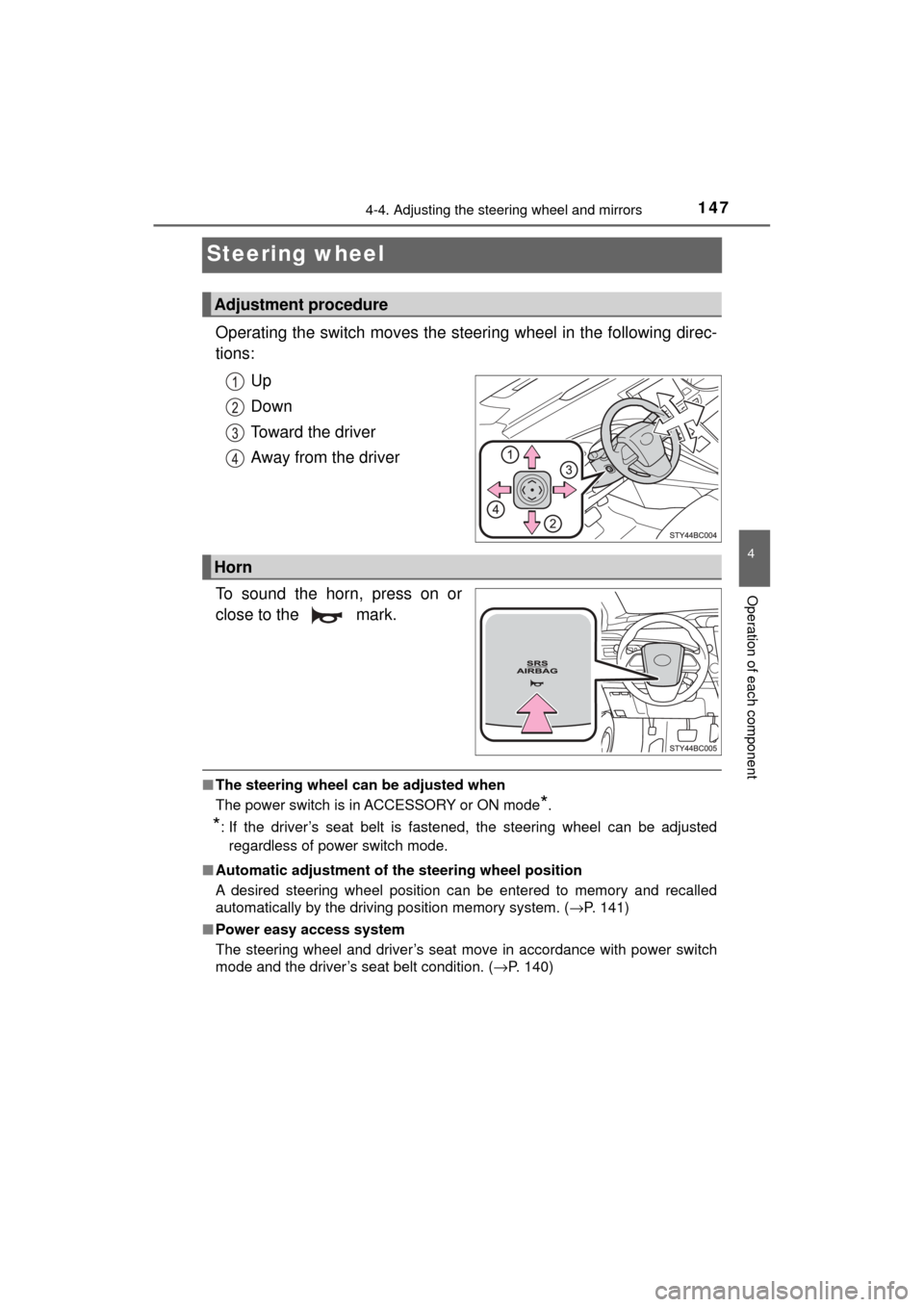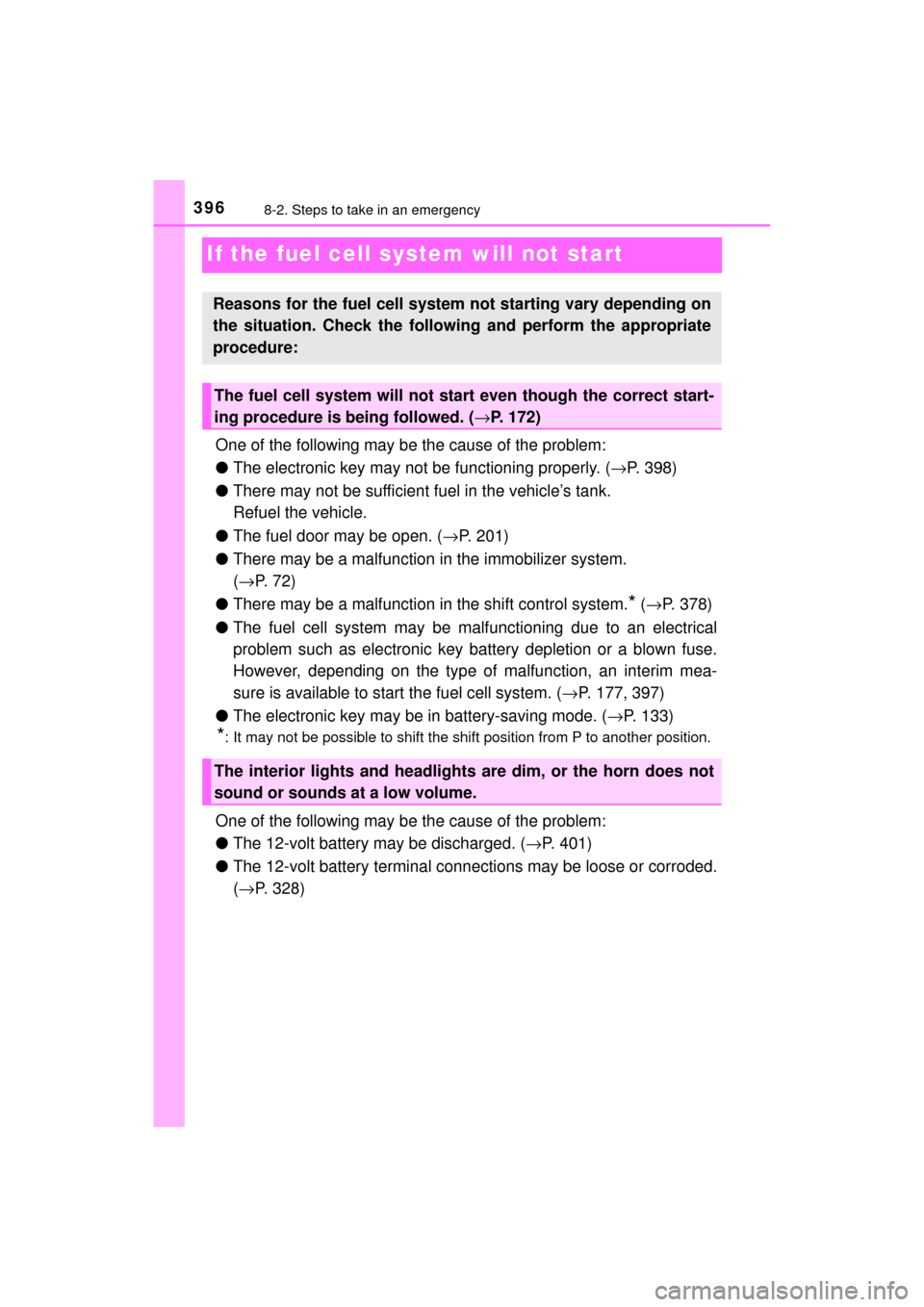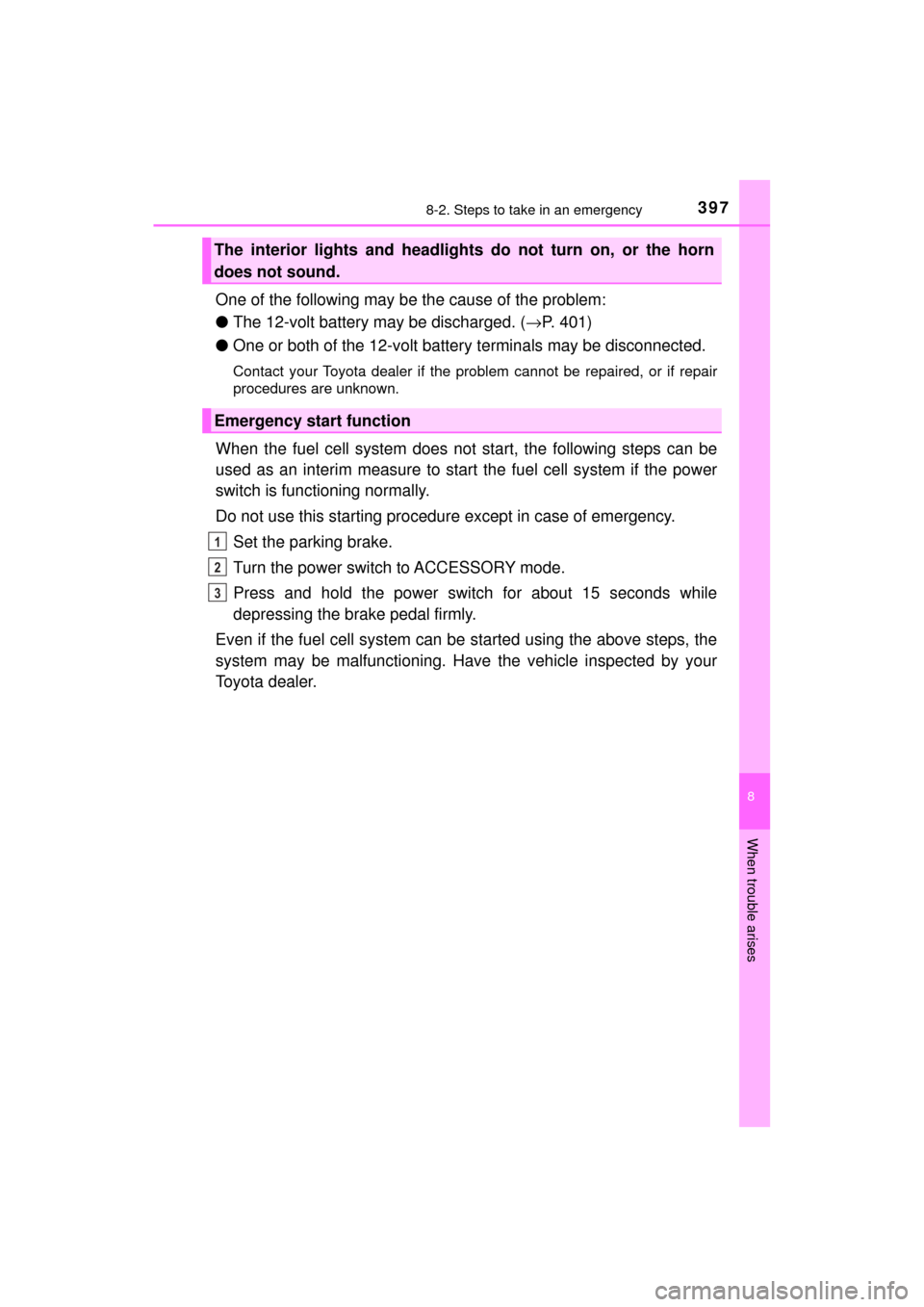2017 TOYOTA MIRAI horn
[x] Cancel search: hornPage 147 of 464

1474-4. Adjusting the steering wheel and mirrors
4
Operation of each component
MIRAI_OM_USA_OM62023U
Steering wheel
Operating the switch moves the steering wheel in the following direc-
tions:Up
Down
Toward the driver
Away from the driver
To sound the horn, press on or
close to the mark.
■ The steering wheel can be adjusted when
The power switch is in ACCESSORY or ON mode
*.
*: If the driver’s seat belt is fastened, the steering wheel can be adjusted
regardless of power switch mode.
■ Automatic adjustment of th e steering wheel position
A desired steering wheel position can be entered to memory and recalled
automatically by the driving position memory system. ( →P. 141)
■ Power easy access system
The steering wheel and driver’s seat move in accordance with power switch
mode and the driver’s seat belt condition. ( →P. 140)
Adjustment procedure
Horn
Page 229 of 464

2295-5. Using the driving support systems
5
Driving
MIRAI_OM_USA_OM62023U■
Sensor detection information
●The sensor’s detection areas are limited to the areas around the vehicle’s
bumper.
● Certain vehicle conditions and the surrounding environment may affect the
ability of a sensor to correctly detect an obstacle. Particular instances where
this may occur are listed below.
• There is dirt, snow or ice on the sensor. (Wiping the sensors will resolve
this problem.)
• The sensor is frozen. (Thawing the area will resolve this problem.)
In especially cold weather, if a sensor is frozen the screen may show an
abnormal display, or obstacles may not be detected.
• The sensor is covered in any way.
• The vehicle is leaning considerably to one side.
• On an extremely bumpy road, on an incline, on gravel, or on grass.
• The vicinity of the vehicle is noisy due to vehicle horns, motorcycle
engines, air brakes of large vehicles, or other loud noises producing ultra-
sonic waves.
• There is another vehicle equipped with parking assist sensors in the
vicinity.
• The sensor is coated with a sheet of spray or heavy rain.
• The vehicle is equipped with a fender pole or wireless antenna.
• Towing eyelets are installed.
• The bumper or sensor receives a strong impact.
• The vehicle is approaching a tall or curved curb.
• In harsh sunlight or intense cold weather.
• The area directly under the bumpers is not detected.
• If obstacles draw too close to the sensor.
• A non-genuine Toyota suspension (lowered suspension etc.) is installed.
• People may not be detected if they are wearing certain types of clothing.
In addition to the examples above, there are instances in which, because of
their shape, signs and other objects may be judged by a sensor to be closer
than they are.
● The shape of the obstacle may prevent a sensor from detecting it. Pay par-
ticular attention to the following obstacles:
• Wires, fences, ropes, etc.
• Cotton, snow and other materials that absorb sound waves
• Sharply-angled objects
• Low obstacles
• Tall obstacles with upper sections projecting outwards in the direction of
your vehicle
Page 396 of 464

3968-2. Steps to take in an emergency
MIRAI_OM_USA_OM62023U
If the fuel cell system will not start
One of the following may be the cause of the problem:
●The electronic key may not be functioning properly. ( →P. 398)
● There may not be sufficient fuel in the vehicle’s tank.
Refuel the vehicle.
● The fuel door may be open. ( →P. 201)
● There may be a malfunction in the immobilizer system.
( → P. 72)
● There may be a malfunction in the shift control system.
* (→ P. 378)
● The fuel cell system may be malf unctioning due to an electrical
problem such as electronic key ba ttery depletion or a blown fuse.
However, depending on the type of malfunction, an interim mea-
sure is available to start the fuel cell system. ( →P. 177, 397)
● The electronic key may be in battery-saving mode. ( →P. 133)
*: It may not be possible to shift the shift position from P to another position.
One of the following may be the cause of the problem:
● The 12-volt battery may be discharged. ( →P. 401)
● The 12-volt battery terminal connections may be loose or corroded.
(→ P. 328)
Reasons for the fuel cell system not starting vary depending on
the situation. Check the follo wing and perform the appropriate
procedure:
The fuel cell system will not start even though the correct start-
ing procedure is being followed. ( →P. 172)
The interior lights and headlights are dim, or the horn does not
sound or sounds at a low volume.
Page 397 of 464

3978-2. Steps to take in an emergency
MIRAI_OM_USA_OM62023U
8
When trouble arises
One of the following may be the cause of the problem:
●The 12-volt battery may be discharged. ( →P. 401)
● One or both of the 12-volt batter y terminals may be disconnected.
Contact your Toyota dealer if the problem cannot be repaired, or if repair
procedures are unknown.
When the fuel cell system does not start, the following steps can be
used as an interim measure to star t the fuel cell system if the power
switch is functioning normally.
Do not use this starting procedure except in case of emergency.
Set the parking brake.
Turn the power switch to ACCESSORY mode.
Press and hold the power switch for about 15 seconds while
depressing the brake pedal firmly.
Even if the fuel cell system can be started using the above steps, the
system may be malfunctioning. Have the vehicle inspected by your
Toyota dealer.
The interior lights and headlight s do not turn on, or the horn
does not sound.
Emergency start function
1
2
3
Page 448 of 464

448What to do if... (Troubleshooting)
MIRAI_OM_USA_OM62023U
●The seat belt reminder light is flashing
Are the driver and the front passenger wearing the seat belts? (→P. 371)
●The brake system warning light is on
Is the parking brake released? (→P. 186)
Depending on the situation, other types of warning buzzer may also sound.
( →P. 369, 376)
●Did anyone inside the vehicle open a door during setting the alarm?
The sensor detects it and the alarm sounds. ( →P. 74)
To stop the alarm, turn the power switch to ON mode or start the fuel cell sys-
tem.
●Is the electronic key left inside the vehicle?
Check the message on the multi-information display. ( →P. 376)
●When a warning light turns on or a warning message or indicator is dis-
played, refer to P. 369, 376.
●Stop the vehicle in a safe place and replace the flat tire with the spare
tire. ( →P. 381)
●Try the procedure for when the vehicle becomes stuck in mud, dirt, or
snow. ( →P. 412)
A warning buzzer sounds during driving
A warning buzzer sounds when leaving the vehicle
An alarm is activated and the horn sounds
A warning light turns on or a warning message or indicator
is displayed
When a problem has occurred
If you have a flat tire
The vehicle becomes stuck
Page 454 of 464

454Alphabetical index
MIRAI_OM_USA_OM62023U
Opening the fuel door ........... 198
Overheating .......................... 406
Power output restriction .......... 88
Power switch......................... 172
Precautions ............................. 82
Regenerative braking.............. 81
Road accident cautions .......... 92
Running out of fuel.................. 85
Service plugs .......................... 91
Sounds and vibrations ............ 80
Starting the system ............... 172
Traction battery air intake vent....................................... 85
Vehicle proximity notification
system ......... ......................... 84
Warning message ................. 376
Water release ....................... 173
Fuel consumption............ 111, 112
Fuel door .................................. 198 Refueling............................... 198
Fuses ........................................ 355
Garage door opener ................ 292
Gauges ..................................... 102
Glove box ................................. 273
Grocery bag hooks .................. 277 H
2O switch ............................... 173
Hands-free system
(for cellular phone)
*
Head restraints ........................ 145
Headlights ................................ 187 Automatic High Beam system .......... ...................... 190
Light switch ........................... 187
Replacing light bulbs ............ 358
Heated steering wheel ............ 267
Heaters Automatic air conditioning system .......... ...................... 258
Heated steering wheel .......... 267
Outside rear view mirrors ..... 261
Seat heaters ......................... 268
High mounted stoplight
Replacing light bulbs ............ 358
High-voltage components ........ 83
Hill-start assist control ........... 232
Hood ......................................... 320 Warning message................. 376
Hooks
Coat hooks ........................... 281
Grocery bag hooks ............... 277
Retaining hooks (floor mat) .... 26
Horn .......................................... 147
Hydrogen detectors .................. 87
Hydrogen-related components............................. 82
Hydrogen tanks ......................... 86 Capacity................................ 418
Location ............................ 78, 82
G
H